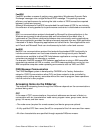
Klinkmann Automation Omron Ethernet DAServer 4
Omron Ethernet DAServer Ver 1.x User Manual Rev 1.3 17014m13
FastDDE
FastDDE provides a means of packing many proprietary Wonderware Dynamic Data
Exchange messages into a single Microsoft DDE message. This packing improves
efficiency and performance by reducing the total number of DDE transactions required
between a client and a server.
Although Wonderware's FastDDE has extended the usefulness of DDE for our industry,
this extension is being pushed to its performance constraints in distributed environments.
DDE
DDE is a communications protocol developed by Microsoft to allow applications in the
Windows environment to send/receive data and instructions to/from each other. It
implements a Client/Server relationship between two concurrently running applications.
The server application provides the data and accepts requests from any other application
interested in its data. Requesting applications are called clients. Some applications such
as InTouch and Microsoft Excel can simultaneously be both a client and a server.
NetDDE
NetDDE is a communications protocol that extends the standard DDE functionality to
include communications over local area networks and through serial ports. Network
extensions are available to allow DDE links between applications running on different
computers connected via networks or modems.
For example, NetDDE supports DDE between applications running on IBM-compatible
computers connected via LAN or modem, and DDE-aware applications running on non-
IBM-compatible computers under operating environments such as VMS and UNIX.
FINS Message Communication
The FINS Messages system is developed by OMRON for its Factory Automation
networks. FINS Communications allow PLCs on these networks to be controlled by
reading and/or writing memory area data without the need to program these operations
into the controller’s user program.
Accessing Items via the DAServer
The method for accessing items through the DAServer depends on the communications
protocol being used.
OPC
In the case of OPC communications, the protocol addresses an element of data in a
conversation with six characteristics: node name, program name, group name, device
group, link name, and item name.
• The node name (required for remote access) and device group are optional.
• A fully qualified OPC Item name (ItemID) is composed of the link name and item name.
• All other characteristics are specified through separate DAServer means.


















